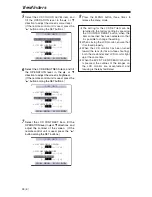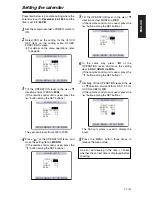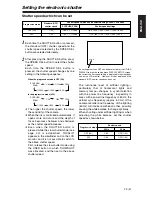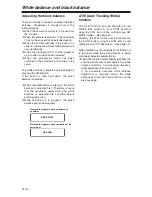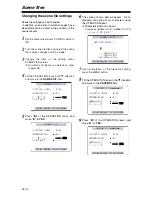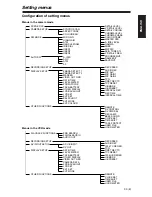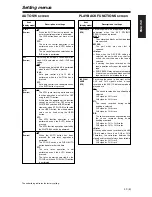
40 (E)
Setting menus
Item/
(display mode)
Description of settings
DETAIL LEVEL
(Camera)
For adjusting the detail amount.
–7
---
0
---
+7
CHROMA LEVEL
(Camera)
For adjusting the chroma level.
–7
---
0
---
+7
CHROMA
PHASE (Camera)
For finely adjusting the chroma phase.
–7
---
0
---
+7
COLOUR TEMP
(Camera)
For finely adjusting the colour temperature
(for performing fine adjustments after the
white balance has been adjusted).
–7
---
0
---
+7
MASTER PED
(Camera)
For adjusting the black master pedestal
which serves as the video reference.
–15
---
0
---
+15
A. IRIS LEVEL
(Camera)
For setting the auto iris target value.
–4
---
0
---
+4
Item/
(display mode)
Description of settings
KNEE
(Camera)
For setting the level (knee point) at which
the high-brightness video signals sensed by
the CCD are to be compressed in order to
minimize colour saturation in the highlights
of the image.
AUTO:
The knee point is set automatically in
accordance with the signals sensed.
LOW:
The knee point is set on the low side
(with compression starting from
around 80%).
MID:
The knee point is set at an interim value
(with compression starting from around
90%).
HIGH:
The knee point is set on the high side
(with compression starting from around
100%).
MATRIX
(Camera)
For selecting the matrix table and
expressing the colours during shooting.
NORM1:
Colors suited to shooting
outdoors or under light sources
using halogen lamps are
expressed.
NORM2:
More vivid colors are expressed
than with the NORM1 setting.
FLUO:
Colours suited to shooting
indoors under fluorescent light
sources are expressed.
CINE-LIKE:
Colours suited to cinema-like
shooting are expressed.
SCENE FILE screen
V DETAIL
(Camera)
For adjusting the strength of the outline
compensation in the vertical direction of the
images.
–7
---
0
---
+7
DTL CORING
(Camera)
For adjusting the level at which the noise in
the detail signals is to be eliminated.
–7 --- 0 --- +7
When this is adjusted in the “–” direction,
clearer images are produced but the noise
increases slightly.
When it is adjusted in the “+” direction, the
noise decreases.
GAMMA
(Camera)
For selecting the gamma curve.
LOW:
Using a gamma curve with a moderate
gradient for the low-luminance areas, the
images are given a calm, composed look.
A sharp touch is conveyed by the contrast.
NORM:
Standard images are produced.
HIGH:
Using a gamma curve with a sharp
gradient for the low-luminance areas, the
gradations of the dark areas are
extended to make them appear brighter.
A soft touch is conveyed by the contrast.
B.PRESS:
Images giving the sense of a sharper contrast
than at the LOW setting are produced.
CINE-LIKE:
The gamma curve which gives the
images a cinema-like finish is used.
Images with less noise than at the
CINE_LIKE_D setting are produced.
CINE-LIKE_D:
The dynamic range is higher than at the
CINELIKE setting.
CINE-LIKE_V:
This uses the gamma curve for finishing
the images into movie-like images where
priority is given to contrast.
In order to make full use of the CINE-
LIKE gamma characteristics, it is
recommended that the lens iris be set
lower (by approx. 1/2) than the regular
video level.
The underlining indicates the factory setting.
Summary of Contents for AG-DVX100A - Pro 3-CCD MiniDV Proline...
Page 71: ...Memo ...

